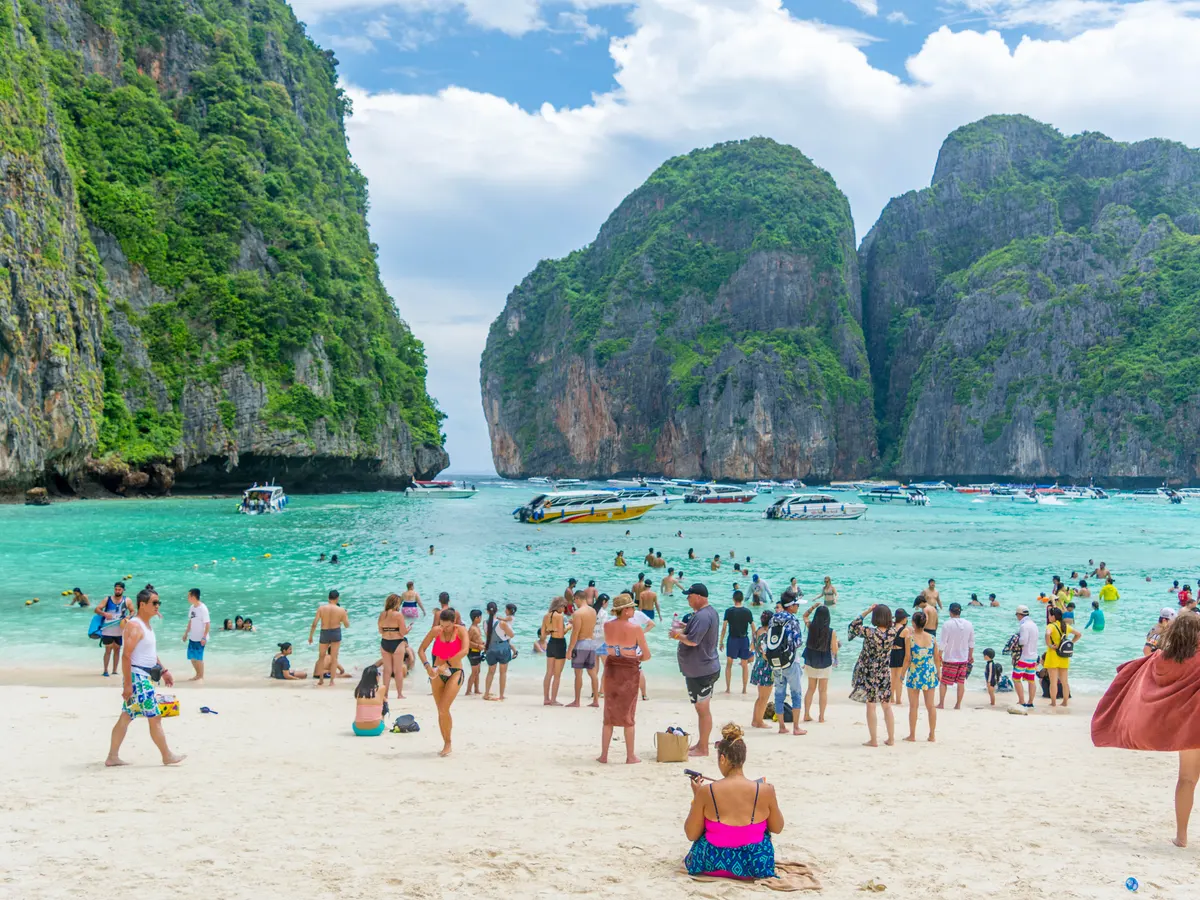Top 10 best beach destinations in the world
A beach is always an excellent location for a relaxing holiday, so it’s no wonder that millions of us flock to a beach destination when we have time to travel. With vast stretches of white sand, clear turquoise waters, waving palm trees, and a tranquil ambiance, vacationing at the beach is always as fun as it sounds. Whether you love relaxing on the sand, snorkeling in clear warm waters, or try the athlete in yourself with exciting watersports, a beach always offers an activity to suit everyone. Of course, not all beach destinations are equally good, so to help you plan your next tropical escape, I share with you my 10 preferred hotspots in the world for a relaxing beach holiday.
10. THAILAND

A veritable paradise of sugar white sand, crystal clear waters, and dramatic scenery, Thailand’s tropical beaches are renowned around the globe for their beauty. Unfortunately, mass tourism has destroyed some of them. Remember The Beach? Well, these days you’ll have to look a little harder to find the utopian paradise of the 1990s cult backpacker novel on Thailand’s Andaman coast. However, little gems still shine brightly on Phi Phi island. And some of the country’s most luxurious resorts – such as the phenomenal resort of.
 Best time to visit: the weather in Thailand is reasonable most times of year, although it certainly gets hot and rainy during the summer. November through February are the coolest times of year and there is certainly less rain than at other times in the year. However, avoid the rainy season (July to October) at all costs since tropical downpours can be torrential.
Best time to visit: the weather in Thailand is reasonable most times of year, although it certainly gets hot and rainy during the summer. November through February are the coolest times of year and there is certainly less rain than at other times in the year. However, avoid the rainy season (July to October) at all costs since tropical downpours can be torrential.
Read More:
9. PHILIPPINES

With more than 7000 islands dotted with beautiful white sand beaches that are lapped by warm aquamarine seas and edged by spectacular coral reefs, picking a favorite beach in the Philippines may sound like a challenging task. El Nido in Palawan, often dubbed as the Philippines’ last frontier, is definitely one the best destinations in the country, not only because of the powder-fine beaches and gin-clear waters, but also because of the area’s fabulous limestone formations, towering cliffs, prehistoric caves and thundering waterfalls.

Read More:
8. NORTHWESTERN USA & CANADA

The Northwestern area of the American continent boasts some of the most spectacular wild beaches in the worlds, in particular Second Beach in Olympic National Park (USA) and Long Beach in the Pacific Rim National Park (Canada). Do not expect a tropical idyll though, since these areas rank among the wettest places on earth. Here, you can walk on miles of long sandy beaches backed by lush, old-growth rainforest, while watching the thundering waves of the Pacific Ocean with the occasional whale breaching at the horizon.
 Best time to visit: it depends on your interests. In the winter you can expect a lot of rain and potentially high winds but many people go just to storm watch. July and August would be the best time in terms of less precipitation, warmer temperatures and sunshine but fog is often a plague in the morning.
Best time to visit: it depends on your interests. In the winter you can expect a lot of rain and potentially high winds but many people go just to storm watch. July and August would be the best time in terms of less precipitation, warmer temperatures and sunshine but fog is often a plague in the morning.
7. QUEENSLAND, AUSTRALIA

Queensland has hundreds of world-class beaches, each offering a distinctive experience. Whitehaven Beach, located on the largest of the Whitsunday Islands, is often voted amongst the world’s most beautiful beaches; stretching over 3,7 miles (6km) and boasting brilliant silica sand, among the purest in the world, you’ll soon realize why. Another favorite is Seventy-five Mile Beach, which is Australia’s premier four-wheel driving location and runs along Fraser Island’s east coast; the fabulous beach boasts miles upon miles of pristine sand and sea, as well as a vast array of wildlife.

Read More:
6. CAPE TOWN, SOUTH AFRICA

Cape Town, often dubbed South Africa’s Mother City and IMHO the world’s most beautiful city, has some of the world’s most spectacular beaches on its doorsteps, just minutes from the city center at the foot of the epic Table Mountain. From the family friendly beaches on the False Bay coastline to the gorgeous beaches for the rich and beautiful on the incredibly spectacular Atlantic Seaboard, you’re sure to find a stretch of sand that suits your fancy. My favorite Capetonian beaches are Camps Bay, Clifton and Llandudno.
 Best time to visit: Cape Town’s hot, dry summer months run from late October to late March. Temperatures reach their peak between December and February, and this is generally seen as when to go to Cape Town for the best beach weather.
Best time to visit: Cape Town’s hot, dry summer months run from late October to late March. Temperatures reach their peak between December and February, and this is generally seen as when to go to Cape Town for the best beach weather.
Read More:
5. HAWAII, USA

Besides jaw-dropping natural scenery (think active volcanoes, towering cliffs, and dense jungle), the Hawaiian islands also boast some of the best beaches in the world. Some built around the high drama of intense waves crashing against razor-sharp lava rocks; some so remote that they are only accessible by helicopter or landing watercraft; and some are so hidden and gorgeous that they need to remain a secret. The islands of Kauai and Maui are best for travelers looking for a relaxing beach holiday (but don’t forget to explore the incredible landscapes outside the resorts).

4. FRENCH POLYNESIA

With 118 islands dotted in the mighty blue South Pacific Ocean, French Polynesia has, as you probably expect, some pretty awesome beaches. Just 12 miles (19 km long), the lush little slipper of land called Bora Bora lies in French Polynesia’s most mesmerizing lagoon edged by fine white sandy shores. Luxurious over-water bungalows nestled over the world’s most beautiful lagoon with a tropical backdrop make Bora Bora a top destination for the discerning traveler.

Read More:
3. TURKS AND CAICOS

The Turks and Caicos Islands have some of the planet’s most ethereal turquoise seas and finest, powdery sand beaches, and are surrounded by the globe’s third-largest coral reef. While their western neighbors of the Bahamas went mass with their lost-on-the-way-to-Las-Vegas resorts, the Turks went class, quietly opening a string of very luxurious resorts in the past decade.
 Best time to visit: like other islands in the Caribbean, Turks & Caicos’ dry seasons and peak travel period lasts from December to March. However, the best time to visit Turks & Caicos is April and May, a sweet spot featuring lower prices and fewer crowds. The weather is pleasant year-round with average highs that hover in the 80s, but these islands do experience a rainy season, and the threat of hurricanes lingers from June to November.
Best time to visit: like other islands in the Caribbean, Turks & Caicos’ dry seasons and peak travel period lasts from December to March. However, the best time to visit Turks & Caicos is April and May, a sweet spot featuring lower prices and fewer crowds. The weather is pleasant year-round with average highs that hover in the 80s, but these islands do experience a rainy season, and the threat of hurricanes lingers from June to November.
2. THE MALDIVES

Located on the equator towards the south of India, and stretching over 500 miles (800 km), the Maldives are the visible coral tips of an oceanic volcanic mountain range whose outer edge at some points plunge to depths of over 2 miles (3 km). The islands are blessed with stunning white beaches, crystal clear blue lagoons, incredible underwater wildlife, and unrivaled luxury esorts.

Read More:
1. THE SEYCHELLES

Mother Nature was extremely generous when she created the archipelago of the Seychelles, comprised of 115 scenic islands scattered in the Indian Ocean east of Kenia. The beauty of the Seychellois beaches is beyond words and unmatched anywhere else in the world: exquisite ribbons of powdery-soft white sand are lapped by turquoise waters and backed by palm tree covered hills and big rocky boulders.





